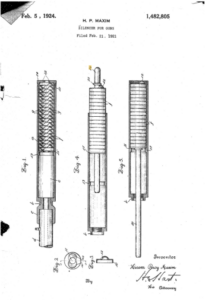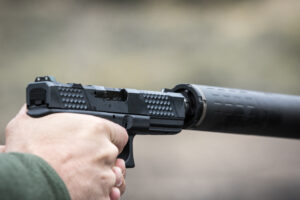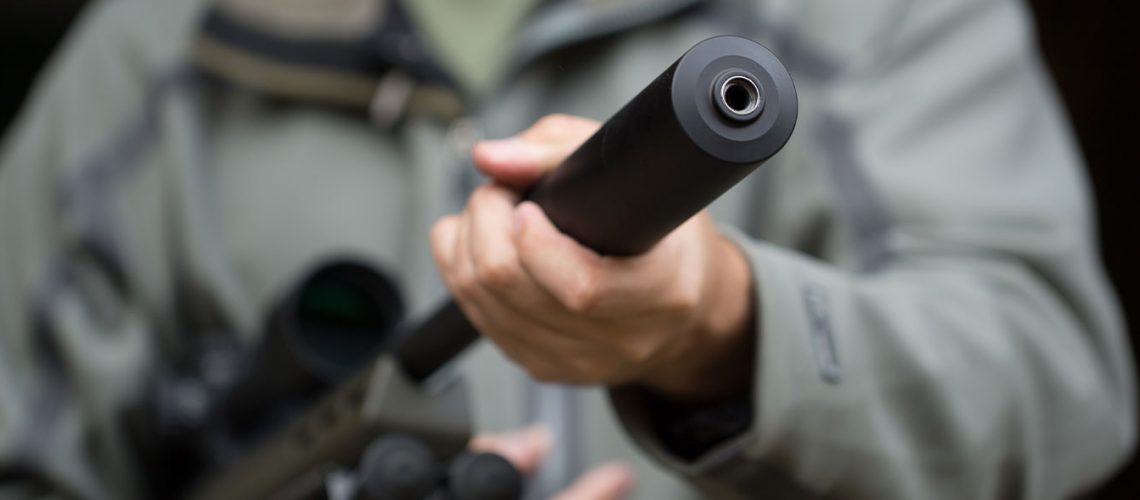Silencers. A lot of people would like one. And, a lot of people—incorrectly—believe you can’t legally own one.
Not only will this article dispel some common myths about silencers, it will actually detail step-by-step how you can go about having a silencer. (If you live in one of the more pro-gun, freedom-loving states, that is.)
 WHERE THEY STARTED
WHERE THEY STARTED
Hiram P. Maxim, son of machine gun inventor Hiram S. Maxim, is credited with inventing the silencer. He patented it in 1909, and even called it a “silencer” himself. It sold for the reasonable price of $3.95. That’s $120 in 2022 money.
In 1934, the National Firearms Act defined what silencers were for legal purposes, and limited their sale and ownership. It is rumored that the fear of the Thompson sub-machine gun was a motivating factor in passing the NFA, along with some notable uses of short-barreled shotguns in organized crime. It is hard to trace exactly how and why silencers ended up on the list of NFA-restricted items.
That National Firearms Act regulates silencers to this very day. It’s why not everyone in every state can have one—and it’s why you have to go through a more rigorous than usual process to own one legally.
AN OCEAN AWAY IN QUALITY
In many European nations, firearms ownership is restricted, but silencers are completely unregulated accessories. In fact, it is even considered rude to shoot without one—like your neighbor revving their motorcycle at 2 a.m. This leads to many exquisite European rifles that are expected to last a lifetime, with features like interchangeable barrels/calibers. Meanwhile, most European suppressors are cheaply manufactured.
In the United States, we have the opposite experience. Firearms are relatively affordable and accessible, but because suppressors are difficult to purchase, they tend to be highly durable pieces of engineering. They’re precision machined from metals like titanium and Inconel (used in jet engine turbines).
SILENCER VS. SUPPRESSOR
The very name “silencer” is a bone of contention. Since nothing can make a fired weapon completely silent, the term “suppressor” has been used by advocates who insist that this term more accurately describes what the apparatus actually does.
On the other hand, while “suppressor” is probably a more accurate term, “silencer” is listed on the original patent, and in the majority of legal definitions and descriptions. And, “silencer” is the more common term to the public a large.
Other than those distinctions? There’s no difference.
Most “silencers”, in fact, can only suppress the sound of a weapon firing by 40 to 60 decibels. For example, a “quiet” round like a .22 can only be suppressed to 110 decibels. Compare that to a car door slamming at 118 decibels, or a car horn at 110 decibels.
So, it’s suppressed, but it’s clearly not silent. It’s also important to note that the only sound that is muffled by the device is the high-pressure gasses coming from the muzzle. All mechanical functions continue to generate the same amount of noise. (Sometimes, a bit more in gas-operated guns that are a bit “over-gassed” from the increased back pressure of a suppressor.)
LEGALITY
Are silencers legal? They sure are. How about suppressors? Well, since they’re two different words for the same thing—yes!
HOW TO GET ONE
Just because suppressors are legal doesn’t mean you don’t have to do a little work to get one. It is more like owning a vehicle intended to be driven on public roads—legal to own, but registration, tax, and other paperwork is required.
First, you have to live in one of the 42 states where they’re legal. Which means you CAN’T live in: California, Hawaii, Illinois, New York, New Jersey, Massachusetts, Rhode Island, or Delaware. These states have additional state-level prohibitions.
(And you can’t hunt with them in Connecticut or Vermont.)
There’s a few other requirements:
Like a handgun, you must be 21 years old or older to purchase from a dealer. (Must be 18 to purchase from an individual, depending on state laws. Must be 18 to possess one as a beneficiary of a trust or member of a corporation, depending on state laws.)
Must be a citizen of the United States.
Must be legally able to purchase a firearm.
Must be able to pass a background check.
Must pay a one-time Transfer Tax of $200.
 You also must know how to submit paperwork, because you’re going to have to fill out paperwork. Starting with the Bureau of Alcohol, Tobacco, Firearms, and Explosives (BATFE’s) form 4 and form 5330.20—in duplicate.
You also must know how to submit paperwork, because you’re going to have to fill out paperwork. Starting with the Bureau of Alcohol, Tobacco, Firearms, and Explosives (BATFE’s) form 4 and form 5330.20—in duplicate.
A silencer may be purchased by an individual, a corporation, or a trust. The required paperwork used to be somewhat different for each of these, but in 2016 it was unified a bit. We’re not going to cover the nuances of each in this article.
Next, you’ll need to get fingerprinted and photographed.
You also must know how to submit paperwork, because you’re going to have to fill out paperwork. Starting with the Bureau of Alcohol, Tobacco, Firearms, and Explosives (BATFE’s) form 4 and form 5330.20—in duplicate.
A silencer may be purchased by an individual, a corporation, or a trust. The required paperwork used to be somewhat different for each of these, but in 2016 it was unified a bit. We’re not going to cover the nuances of each in this article.
Next, you’ll need to get fingerprinted and photographed.
Then, you’ll need to pay the BATFE that one-time $200 transfer fee, also referred to as a tax stamp (yes, you literally do receive a stamp in the mail).
After the BATF gets your paperwork, and the fee, and approves form 4, a dealer is then authorized to transfer the silencer to you, (using standard form 4473.)
If you want to buy another silencer? Well, you’ll repeat this process—including $200 for each and every silencer you buy.
There’s a key update that went into effect at the end of 2021—The BAFTE is no using eForms (an electronic form filing and application system) for the form 4. eForms have been used by manufacturers for some time for the creation of NFA items (form 1). Form 4 going digital will likely have a rocky start, but should provide a notable improvement to processing and wait times. With the eForm, wait times are anticipated to be around 3 months. Previously, FLP staff members reported waiting 9-13 months for their paperwork to be processed (while the already paid-for silencer sits in the display case at the dealer).
KEY ADVANTAGES
Reduces hearing loss or damage
Reduced recoil means easier firing and greater accuracy
Reduces noise pollution and complaints
Facilitates better communication with others
Increased awareness overall without earplugs
DISADVANTAGES/OBSTACLES
Increased back pressure and “gas in the face” in many semi-auto rifles
Your gun will get dirtier much faster
Potential point-of-impact shift
Increased weight and length of the weapon system
You may have to adjust some parts to cycle reliably (gas block, buffer, etc.)
You must have a threaded barrel
DISPELLING MYTHS
”Silencers affect your bullet.” Wrong. The bullet doesn’t interact with the silencer AT ALL. (It shouldn’t, at least. A baffle strike from an improperly mounted device is dangerous and damaging to the silencer.) And, the silencer doesn’t make it slower. If anything, it may be a few FPS faster due to increased pressure.
”Silencers are used for crime.” Considering that the ATF can’t find a single example of a legal silencer owner committing a violentcrime with one in the last decade? The “used for crime” myth is extremely mythical. The only significant crimes related to suppressors are illegal transfers or unregistered devices.
”It’s illegal to own a silencer.” (We’re well past having to explain that at this point, aren’t we?)
”Silencers make things completely silent.” (We’ve been down that road, too, haven’t we?) A subsonic 22LR with a “can” is about the quietest it is ever going to be.
“Silencers are just for tactical operations.” Quite false. One of the fastest growing applications of silencers is for hunters. It is hard to hear game when wearing ear protection, so making the rifle quieter can help reduce ear damage.
Can you legally own a silencer or suppressor? YES. Does it take a little work in terms of paperwork? You bet. Is it worth it? The advantages are there. So, take advantage of them, and enjoy.


